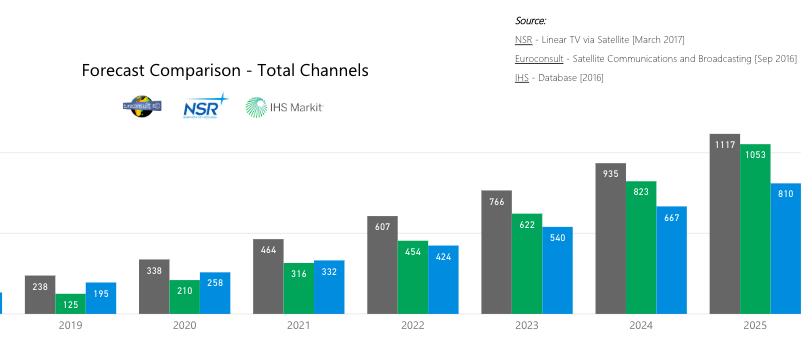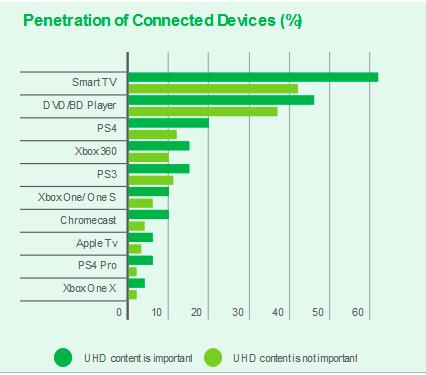Four Simple Steps to Launch Your Ultra HD Channel

You have no doubt already read about how Ultra HD has been steadily developing since 2015. Consumers are captivated by the true-to-life experience, the visual quality, and the colour dimensions that Ultra HD offers. As sales of Ultra HD TVs continues to rise—now surpassing the number of HD TVs sold—the market is ready for more Ultra HD content. Are you ready to launch your Ultra HD channel and capture millions of new viewers around the globe?
Whether it’s the incredible growth and increased demand for Ultra HD content, or the opportunity to increase your revenues, now’s the time to plan your launch—and we can help you get there.
According to Euroconsult analysts, the Ultra HD Channel landscape is growing quickly. Over the next three years, channel availability will grow from 238 to 607. Over five years that number will climb to 935. And those numbers are conservative1.

What your customers want, but can’t get—yet
While it’s great to be a part of a growing market, you might be wondering if the effort is worth it. If satisfying your consumers’ cravings for a great viewing experience isn’t enough—how about their willingness to pay more?
A recent study found that more than half of TV viewers in Germany would be willing to spend money on TV channels in Ultra HD quality. The same study confirmed that 20% of households would pay upwards of €6 per month2.
It’s time to bring an unparalleled experience to your customers, the right way. Successfully launching an Ultra HD broadcast requires thoughtfully considering the entire process, from distribution model and content creation right through to delivering a high-quality transmission to the customer’s home.
Step 1: Distribution Routes
Pay special attention to your decision on distribution business models—and which one best suits your needs. Will you broadcast your content, or make it available as part of a streaming OTT video platform, or both? You need to ensure that you use the right standards for the platforms you intend to use. If you choose an OTT distribution model, remember that satellite can contribute to all TV infrastructures, feeding cable head-ends or terrestrial towers with high-quality Ultra HD content. This enables you to offload your network, since the video is only transmitted via the terrestrial network for the last mile to the customer’s home. And with the growth in Ultra HD TV sales, you’ll benefit from a broad distribution strategy.

Analyst David Mercer reports that the number of homes worldwide using an Ultra HD TV has now passed the 200 million mark, while global sales in 2018 are expected to reach 106.6 million units and are forecast to exceed 190 million by 20233.
For those broadcasters considering OTT in their distribution strategy, analyst Jasmine Enberg predicted that more than half of the US population would view content on a subscription OTT service at least once per month. That equates to 170.1 million people. By 2022, OTT users in the US alone are expected to increase to 197.7 million4.
Whether via OTT or linear broadcast, customers have made it clear that they want more Ultra HD content and are willing to pay for it. That’s a pretty good incentive to launch your Ultra HD channel now
Step 2: Creating UHD Content and Managing for Distribution
Your content needs to be in native Ultra HD, meaning it needs to be recorded using Ultra HD cameras. Post-production is equally important with the media conversion process properly preparing the content for your chosen distribution route(s).
Codecs, such as High Efficiency Video Coding (HEVC) reduce the size of the video file without compromising on quality. What’s the benefit? Compression using HEVC means broadcasters can transmit one Ultra HD channel within the same bandwidth needed for two HD channels encoded in H.264.
Step 3: Getting your Content Out There
In the past, broadcasters were faced with a myriad of technologies, delivery systems, and challenges, making the business case for Ultra HD seem costly with unknown returns. Today, whom you partner with for delivery and management makes all the difference. With the likes of Amazon, Facebook, YouTube, and Netflix committing to Ultra HD for their customers, the demand for improvements on delivery has never been so high.
Content transmitted via satellite is multiplexed, meaning it is combined with multiple content streams into a single signal. That signal is then uplinked from a teleport to the satellite, which is then transmitted to all DTH households within the coverage area. For OTT, the content passes through a content delivery network (CDN) on the way to the customer.
This is where satellite really shines. SES and MX1 are able to seamlessly deliver beautifully created content to customers anywhere in the world—for viewing on any device. One unified platform enables broadcasters to easily handle the various tasks of managing, monitoring, and delivering linear or non-linear content to any broadcast, VOD, or OTT outlet.
Choosing the right partner means your business can treat Ultra HD as an outsourced operating expense and service. Instead of having to manage some or all of the distribution process, your team can stay focused on content production and customer acquisition.
Step 4: Content Comes to Life
If the signal is arriving via terrestrial or satellite links, your customer’s set-top box (STB) will decode it for their viewing pleasure. For OTT content streamed over the Internet, the OTT application will decode it making it ready for the Ultra HD Screen. For your customer, it’s as simple as choosing your channel. The right partner will not only help you deliver your content to your viewers—they will also help you create an effective end-to-end system, including selecting the right Customer Premises Equipment (CPE) to ensure your customers have the best possible experience from day one.
The Time to Launch is Now
Ultra HD is proving to be a market opportunity ripe with demand and exponential market growth. Coupled with a simple approach to the launch process, isn’t it time to get started launching your Ultra HD channel?
1 “Satellite Communications and Broadcasting”. Euroconsult, September 2016.
2 “HD & Ultra HD Monitor 2018”. S&L Research, November 2018.
3 “4K and 8K Ultra HDTV Global Market Forecast”. Strategy Analytics, Decmeber 2018.
4 “Bundle Up!” eMarketer, August 2018.
Related Content
| View the Ultra HD page | |
| Download the Ultra HD eBook |




